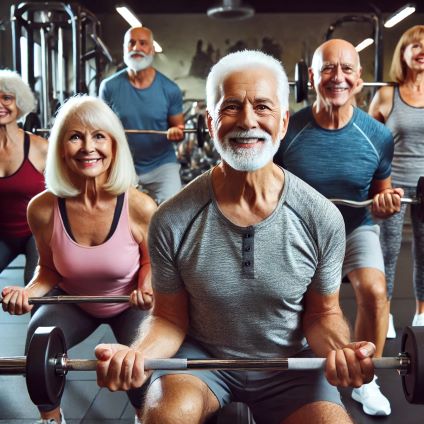Exercise Progression: A Guide to Safe and Effective Movement
Exercise is a fundamental aspect of maintaining overall health, improving mobility, and enhancing strength. However, progressing safely through different levels of exercise is crucial, especially for those recovering from injuries, managing chronic conditions, or beginning a fitness journey. Below is a structured progression of exercise, ranging from passive movements for rehabilitation to heavy-weight resistance training for strength building.
I. Passive Range of Motion (ROM) Exercises
When recovering from an injury or dealing with sensitive joints and muscles, passive range of motion (ROM) exercises are the safest and most effective way to maintain flexibility and prevent stiffness. Unlike active exercises, passive ROM is performed with external assistance—either from a therapist, a caregiver, or even mechanical aids—without the patient exerting any muscle effort.
Who Benefits?
- Individuals recovering from acute injuries such as fractures, muscle tears, or post-surgical procedures.
- Patients with neuromuscular conditions, including stroke, paralysis, or severe muscle weakness (flaccidity).
- Those with high-risk bone conditions such as severe osteoporosis or metastatic bone cancer, where excessive movement can pose a fracture risk.
Benefits of Passive ROM:
- Maintains joint mobility and prevents stiffness.
- Aids in scar tissue formation during the healing process.
- Reduces the risk of contractures (permanent shortening of muscles or joints).
- Enhances circulation and prevents complications like deep vein thrombosis (DVT).
Passive ROM exercises are commonly used in the acute phase of recovery and gradually transition into more active movements as the individual regains strength and control.
II. Active Range of Motion (AROM) Exercises
Active range of motion exercises involve movement performed independently, without assistance. These are entry-level exercises for individuals who are sedentary or in the early stages of a fitness or rehabilitation program.
When to Start?
- During the subacute phase of recovery when pain is manageable.
- For individuals starting a low-impact fitness routine.
- As a warm-up phase for stretching, resistance training, or sports.
Benefits of Active ROM:
- Helps improve muscle coordination and reactivates weak muscles.
- Enhances joint mobility and circulation.
- Provides a safe, gravity-based resistance, reducing the risk of injury.
- Prepares muscles and joints for progressive strengthening exercises.
Common examples include shoulder circles, knee extensions, and ankle pumps, often performed in a controlled, low-impact manner.
III. Manual Resistance Exercises
Manual resistance exercises involve external resistance applied by a therapist or a partner to challenge muscles and joints at varying intensities. This type of training is particularly effective in rehabilitation settings and allows for customized resistance levels depending on the individual's recovery stage.
When to Use Manual Resistance?
- After the initial healing phase when light resistance can be tolerated.
- When muscles are weak and need guided strengthening.
- In cases of post-injury joint instability that requires gradual strengthening.
Techniques and Benefits:
- Resistance is applied by a therapist's hands, allowing for adjustments based on pain tolerance and mobility.
- Can incorporate joint play and mobilization to restore optimal joint movement.
- Aids in muscle re-education and control, especially in conditions like stroke or post-surgical recovery.
- Prepares muscles for more intense weight-bearing and resistance training.
Examples include manual-resisted leg raises, guided shoulder abduction, and assisted trunk rotations. These exercises ensure controlled progression while minimizing stress on healing tissues.
IV. Light Resistance Training
Light resistance training incorporates TheraBands, light dumbbells, body weight, or small resistance tools to improve endurance, tone muscles, and build foundational strength. It serves as a transition phase before progressing to heavier resistance training.
Who Benefits?
- Individuals recovering from injuries who need gentle muscle activation.
- Older adults looking to maintain muscle tone and function.
- People returning to fitness after sedentary periods.
- Those aiming to improve stability and endurance without focusing on muscle bulk.
Benefits of Light Resistance Training:
- Improves neuromuscular coordination without excessive strain.
- Helps in injury prevention by reinforcing muscle control.
- Maintains joint integrity while promoting circulatory health.
- Supports muscle reconditioning before progressing to heavier weights.
Examples include resistance band shoulder presses, seated leg extensions, and light dumbbell curls.
V. Heavy Resistance Training (Strength Training)
Heavy resistance training, also known as strength training, involves progressive overload using heavier weights to increase muscle mass, enhance power, and improve body composition. This is the final stage in the exercise progression and is crucial for muscle growth, athletic performance, and age-related muscle loss prevention.
Who Benefits?
- Athletes and fitness enthusiasts aiming for muscle hypertrophy and performance gains.
- Older adults combating sarcopenia (age-related muscle loss).
- Individuals seeking to reshape and sculpt their body.
- Those with osteopenia or osteoporosis, as resistance training can improve bone density.
Benefits of Heavy Resistance Training:
- Increases muscle mass and metabolism, aiding in weight management.
- Improves bone strength and reduces the risk of fractures.
- Enhances postural support and joint stability.
- Slows down age-related muscle deterioration, promoting independence in older adults.
Common exercises include deadlifts, squats, bench presses, and weighted lunges, typically performed with dumbbells, barbells, or machines.
